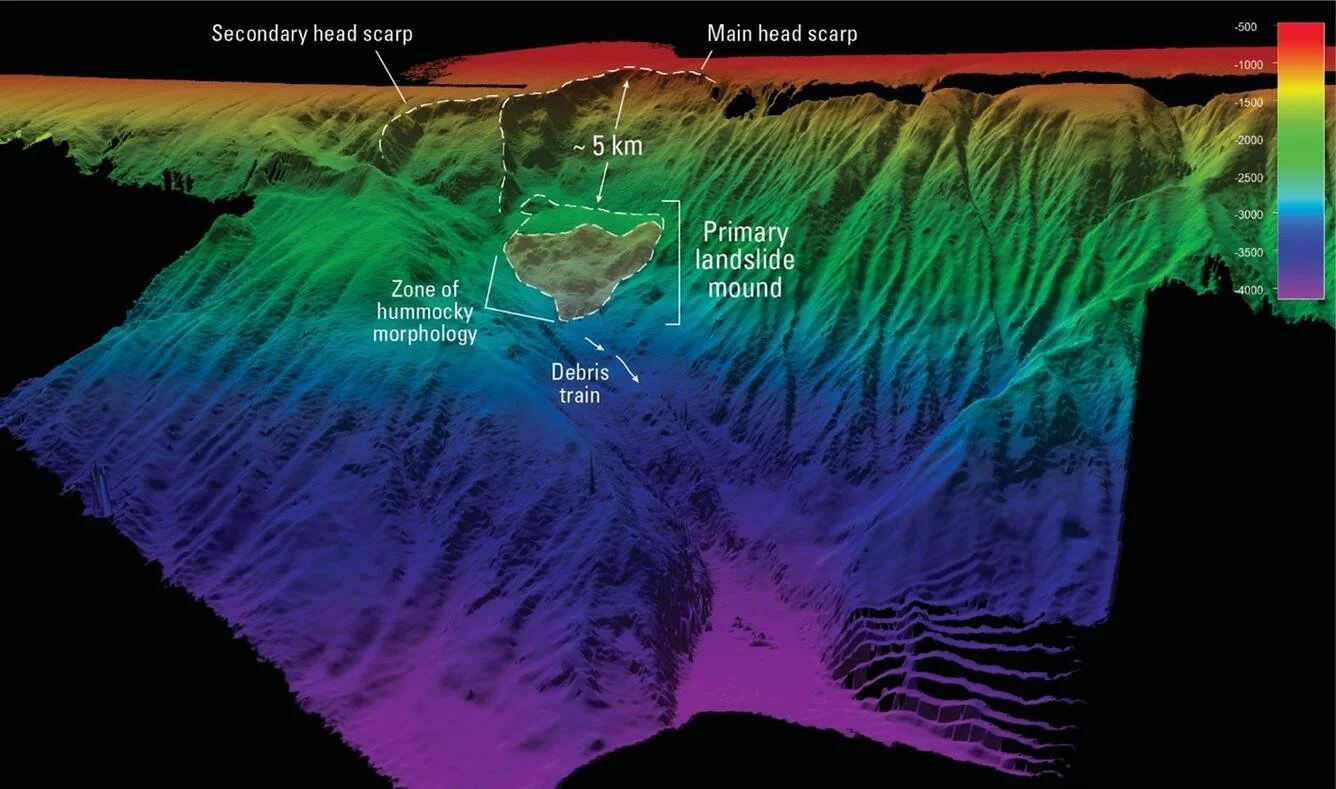Discovery of a Massive Submarine Landslide Near the 1957 Aleutian Earthquake Epicenter — USGS Volcano Watch
As part of a growing national effort to understand seafloor hazards, scientists from the United States Geological Survey’s (USGS) Volcano Science Center (VSC) are working across agencies to investigate how submarine earthquakes, landslides, and volcanic activity shape tsunami risk—not just in Hawaiʻi, but across the broader Pacific.
Colored 3D perspective map of the seafloor on the southern Aleutian Shelf, approximately 18 miles south of Little Tanaga and Umak Islands, Alaska. Colors shows depth, ranging from the shallow shelf 1600 feet (500 meters) below sea level in red, to the deep seafloor 13,000 feet (4000 meters) below sea level in purple. The data was collected using the Office of Naval Research’s Research Vessel (R/V) Atlantis multibeam sonar. The area of the newly discovered submarine landslide is shown in the closed dash shaded line.
In June 2025, a multi-agency expedition led by the USGS, the Bureau of Ocean Energy Management (BOEM), the National Oceanic and Atmospheric Administration (NOAA), the Smithsonian, and the Woods Hole Oceanographic Institution, explored over 2,200 miles of the Aleutian margin aboard the Office of Naval Research’s Research Vessel (R/V) Atlantis.
Crew of the Office of Naval Research’s Research Vessel (R/V) Atlantis and the Woods Hole Oceanographic Institution (WHOI) deploying the U.S. Navy’s three-person human-occupied vehicle (HOV) Alvin submarine. Image courtesy of The Aleutian Arc: Integrated Exploration of Biodiversity at Priority Benthic Habitats. Photographer: Art Howard.
USGS geophysicist and oceanographer Dr. Ashton Flinders of the Hawaiian Volcano Observatory (HVO) led the volcano, earthquake, and landslide hazard component of the expedition. Using the U.S. Navy’s human-occupied vehicle (HOV) Alvin, the mission focused on understanding how tectonic activity, submarine volcanoes, and deep-sea ecosystems interact to shape geologic hazards and ocean-floor habitats.
(HOV) Alvin is a deep-diving submarine capable of carrying two scientists and a pilot to depths of more than 20,000 feet to explore and sample the seafloor. First launched in 1964, Alvin has undergone numerous upgrades—including a major retrofit completed in 2022—and has played a key role in historic missions such as the exploration of the RMS Titanic wreck and hydrothermal vent discoveries. A highlight of the mission included Flinders’ dive to 5,300 feet below the sea surface on the flanks of Bogoslof Volcano to investigate its eruptive history and submarine structure.
Over the course of the expedition, the team collected 884 scientific samples, including 444 biological specimens, 29 geologic samples, and hundreds of liters of seawater. The Atlantis traveled nearly 2,200 miles, with the ship’s multibeam sonar mapping more than 2,500 square miles of previously uncharted seafloor.
The U.S. Navy’s human-occupied vehicle (HOV) Alvin, operated by the Woods Hole Oceanographic Institution (WHOI), as it submerges below the sea surface. The submarine carries two scientists and a pilot. The Office of Naval Research’s Research Vessel (R/V) Atlantis can be seen in the background. Dives are typically five to nine hours in duration and can be as deep as 21,000 feet below sea level. Image courtesy of The Aleutian Arc: Integrated Exploration of Biodiversity at Priority Benthic Habitats. Photographer: Art Howard.
Among the most significant discoveries was a massive submarine landslide structure along the southern slope of the Aleutian Shelf, about 10 miles (16 km) northwest of the epicenter of the 1957 Andreanof Islands earthquake. The landslide spans over 10 miles (16 km) across and exhibits classic signs of rapid slope failure: a scalloped headwall, a chaotic debris zone, and long runout lobes descending toward the deeper basin.
The 1957 earthquake, which struck on March 9 with a magnitude of 8.6, produced a Pacific-wide tsunami that devastated parts of Alaska and Hawaiʻi. In the Hawaiian Islands, waves reached 53 feet at Hāʻena, Kauaʻi, and up to 12 feet in Hilo Bay, and caused millions of dollars in damage. Seismic and tsunami models have raised questions about whether a submarine landslide helped generate the large run-ups observed, similar to 1946.
The newly discovered landslide may help resolve this mystery. If it was triggered by shaking from the 1957 earthquake, the submarine landslide could have acted as a secondary tsunami source, enhancing wave energy directed toward Hawaiʻi. This would parallel the 1946 Aleutian tsunami, which was later linked to a massive submarine landslide off Unimak Island that killed 159 people in Hawaiʻi and destroyed the Scotch Cap Lighthouse on Unimak Island, Alaska, and killed 5 persons there.
Further study is needed to determine the slide’s precise age and volume, but its scale, location, and alignment with tsunami deposits preserved locally in the onshore stratigraphy on several Aleutian islands and in Hawaiʻi, make it a potential candidate for involvement in the 1957 earthquake and tsunami. USGS scientists from the Alaska Volcano Observatory will be leading follow-up investigations to assess the potential tsunami effects of this slide, as well as several newly mapped volcanic landslides throughout the Aleutian Arc.
This discovery highlights the power of modern ocean exploration tools such as multibeam and backscatter sonar to uncover long-hidden geologic hazards as well as the importance of imaging the submarine geology. It also underscores the importance of revisiting historical disasters with new perspectives—and new technology—to better assess tsunami risks for Alaska, Hawaiʻi, and the broader Pacific region.
Volcano Watch is a weekly article and activity update written by U.S. Geological Survey Hawaiian Volcano Observatory scientists and affiliates.



